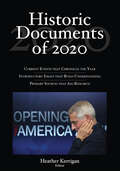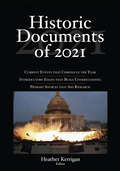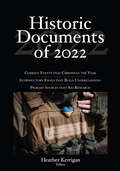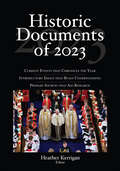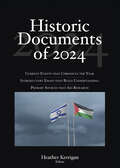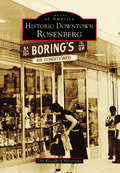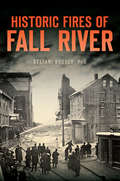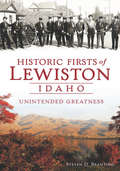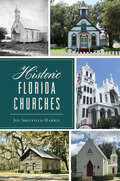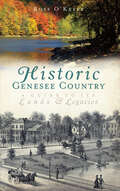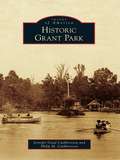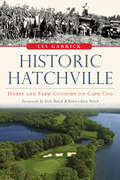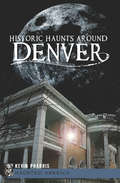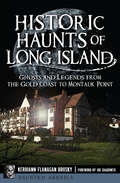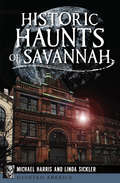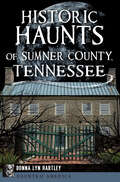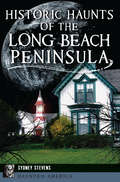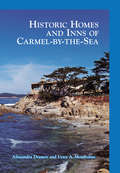- Table View
- List View
Historic Documents of 2020 (Historic Documents)
by Heather KerriganPublished annually since 1972, the Historic Documents series has made primary source research easy by presenting excerpts from documents on the important events of each year for the United States and the World. Each volume pairs 60 to 70 original background narratives with well over 100 documents to chronicle the major events of the year, from official reports and surveys to speeches from leaders and opinion makers, to court cases, legislation, testimony, and much more. Historic Documents is renowned for the well-written and informative background, history, and context it provides for each document. Organized chronologically, each volume covers the same wide range of topics: business, the economy and labor; energy, environment, science, technology, and transportation; government and politics; health and social services; international affairs; national security and terrorism; and rights and justice. Each volume begins with an insightful essay that sets the year’s events in context, and each document or group of documents is preceded by a comprehensive introduction that provides background information on the event. Full-source citations are provided. Readers have easy access to material through a detailed, thematic table of contents, and each event includes references to related coverage and documents from the last ten editions of the series.
Historic Documents of 2020 (Historic Documents)
by Heather KerriganPublished annually since 1972, the Historic Documents series has made primary source research easy by presenting excerpts from documents on the important events of each year for the United States and the World. Each volume pairs 60 to 70 original background narratives with well over 100 documents to chronicle the major events of the year, from official reports and surveys to speeches from leaders and opinion makers, to court cases, legislation, testimony, and much more. Historic Documents is renowned for the well-written and informative background, history, and context it provides for each document. Organized chronologically, each volume covers the same wide range of topics: business, the economy and labor; energy, environment, science, technology, and transportation; government and politics; health and social services; international affairs; national security and terrorism; and rights and justice. Each volume begins with an insightful essay that sets the year’s events in context, and each document or group of documents is preceded by a comprehensive introduction that provides background information on the event. Full-source citations are provided. Readers have easy access to material through a detailed, thematic table of contents, and each event includes references to related coverage and documents from the last ten editions of the series.
Historic Documents of 2021 (Historic Documents)
by Heather Kerrigan River Horse Communications, LLCThe Historic Documents of 2021 makes primary source research easy by presenting excerpts from documents on the important events of the United States and the World. The Historic Documents of 2021 pairs 60 to 70 original background narratives with well over 100 documents to chronicle the major events of the year, from official reports and surveys to speeches from leaders and opinion makers, to court cases, legislation, testimony, and much more. Historic Documents is renowned for the well-written and informative background, history, and context it provides for each document. Organized chronologically, it covers the same wide range of topics: business, the economy and labor; energy, environment, science, technology, and transportation; government and politics; health and social services; international affairs; national security and terrorism; and rights and justice.
Historic Documents of 2021 (Historic Documents)
by Heather Kerrigan River Horse Communications, LLCThe Historic Documents of 2021 makes primary source research easy by presenting excerpts from documents on the important events of the United States and the World. The Historic Documents of 2021 pairs 60 to 70 original background narratives with well over 100 documents to chronicle the major events of the year, from official reports and surveys to speeches from leaders and opinion makers, to court cases, legislation, testimony, and much more. Historic Documents is renowned for the well-written and informative background, history, and context it provides for each document. Organized chronologically, it covers the same wide range of topics: business, the economy and labor; energy, environment, science, technology, and transportation; government and politics; health and social services; international affairs; national security and terrorism; and rights and justice.
Historic Documents of 2022 (Historic Documents)
by Heather Kerrigan River Horse Communications, LLCPublished annually since 1972, the Historic Documents series has made primary source research easy by presenting excerpts from documents on the important events of each year for the United States and the World. Each volume pairs 60 to 70 original background narratives with well over 100 documents to chronicle the major events of the year, from official reports and surveys to speeches from leaders and opinion makers, to court cases, legislation, testimony, and much more.
Historic Documents of 2022 (Historic Documents)
by Heather KerriganPublished annually since 1972, the Historic Documents series has made primary source research easy by presenting excerpts from documents on the important events of each year for the United States and the World. Each volume pairs 60 to 70 original background narratives with well over 100 documents to chronicle the major events of the year, from official reports and surveys to speeches from leaders and opinion makers, to court cases, legislation, testimony, and much more.
Historic Documents of 2023
by Heather KerriganPublished annually since 1972, the Historic Documents series has made primary source research easy by presenting excerpts from documents on the important events of each year for the United States and the World. Each volume pairs 60 to 70 original background narratives with well over 100 documents to chronicle the major events of the year, from official reports and surveys to speeches from leaders and opinion makers, to court cases, legislation, testimony, and much more. Historic Documents is renowned for the well-written and informative background, history, and context it provides for each document. Organised chronologically, each volume covers the same wide range of topics: business, the economy and labor; energy, environment, science, technology, and transportation; government and politics; health and social services; international affairs; national security and terrorism; and rights and justice. Each volume begins with an insightful essay that sets the year’s events in context, and each document or group of documents is preceded by a comprehensive introduction that provides background information on the event. Full-source citations are provided. Readers have easy access to material through a detailed, thematic table of contents, and each event includes references to related coverage and documents from the last ten editions of the series.
Historic Documents of 2023
by Heather Kerrigan River Horse Communications, LLPPublished annually since 1972, the Historic Documents series has made primary source research easy by presenting excerpts from documents on the important events of each year for the United States and the World. Each volume pairs 60 to 70 original background narratives with well over 100 documents to chronicle the major events of the year, from official reports and surveys to speeches from leaders and opinion makers, to court cases, legislation, testimony, and much more. Historic Documents is renowned for the well-written and informative background, history, and context it provides for each document. Organised chronologically, each volume covers the same wide range of topics: business, the economy and labor; energy, environment, science, technology, and transportation; government and politics; health and social services; international affairs; national security and terrorism; and rights and justice. Each volume begins with an insightful essay that sets the year’s events in context, and each document or group of documents is preceded by a comprehensive introduction that provides background information on the event. Full-source citations are provided. Readers have easy access to material through a detailed, thematic table of contents, and each event includes references to related coverage and documents from the last ten editions of the series.
Historic Documents of 2024 (Historic Documents)
by Heather KerriganPublished annually since 1972, Historic Documents provides an unparalleled collection of primary sources that chronicle the most significant events of each year in the United States and around the world. Each edition features 60 to 70 original background narratives and more than 100 primary source documents—including official reports, speeches, legislation, court decisions, testimony, and more. Known for its exceptional editorial quality, the series offers expertly written context for each document, making primary source research accessible and meaningful. Organized chronologically, the volume covers key developments across a wide range of areas including politics, the economy, labor, international affairs, rights and justice, health, science, environment, and national security. A comprehensive introductory essay situates the year’s events, while full-source citations, a detailed thematic table of contents, and cross-references to the past decade of volumes enhance usability for researchers, educators, and students alike.
Historic Documents of 2024 (Historic Documents)
by Heather KerriganPublished annually since 1972, Historic Documents provides an unparalleled collection of primary sources that chronicle the most significant events of each year in the United States and around the world. Each edition features 60 to 70 original background narratives and more than 100 primary source documents—including official reports, speeches, legislation, court decisions, testimony, and more. Known for its exceptional editorial quality, the series offers expertly written context for each document, making primary source research accessible and meaningful. Organized chronologically, the volume covers key developments across a wide range of areas including politics, the economy, labor, international affairs, rights and justice, health, science, environment, and national security. A comprehensive introductory essay situates the year’s events, while full-source citations, a detailed thematic table of contents, and cross-references to the past decade of volumes enhance usability for researchers, educators, and students alike.
Historic Downtown Rosenberg
by The Rosenberg HistoriansRosenberg was created and thrived with the expansion of the railroad. From the first house in 1883, the city grew to become the "Hub of the Gulf Coast." Rosenberg was the center of commerce for settlers of all nationalities attracted here by fertile land and economic opportunity. In just 30 years, 56 businesses, including banks, loan and land development companies, merchants, doctors, and lawyers, were in the four-block area of the original Downtown Rosenberg Business District. Even celebrities came. For instance, outlaws Bonnie and Clyde ate their last meal at the Eagle Café in 1934. Also, actors John Wayne, Shirley Temple, and Roy Rogers could occasionally be found outside the Cole Theater, and while campaigning, Lyndon B. Johnson had his helicopter land on a downtown roof.
Historic Fires of Fall River (Disaster)
by Stefani KooreyFall River's textile boom in the nineteenth century brought with it a series of fiery disasters. The Big Fire of 1843 left more than one thousand people homeless and destroyed two hundred buildings, as well as twenty-some acres of land. After the Steiger Store Fire of 1916, mill owners pushed the city to replace horse-drawn brigades with fire engines. The intense heat from the Kerr Mill Thread Fire of 1987 melted hoses as first responders battled the blaze. Author Stefani Koorey chronicles the historic infernos of the Spindle City and celebrates the community's resilience in the face of adversity.
Historic Firsts of Lewiston, Idaho: Unintended Greatness
by Steven D. BrantingWhen a group of intrepid gold prospectors set up camp at the fork of the Snake and Clearwater Rivers in 1861, they expected to make camp for a night and move on. Instead, they made a town. It was an important--if unintended--accomplishment. And it was only the beginning of a long line of historic firsts for Lewiston, including the first capital, police department, newspaper and post office. Lewiston also boasted the state's first brewery and first vigilante association, both founded in the same year, appropriately enough. Join local historian and lifelong educator Steven D. Branting as he offers the first-ever chronology of unprecedented events, accolades and incidents that shaped Lewiston and Idaho from the city's founding to the present day.
Historic Florida Churches
by Joy Sheffield HarrisAuthor Joy Sheffield Harris guides readers on an architectural tour through the religious diversity of the Sunshine State . Over 200 years have passed since the first Florida church was established and today the Cathedral Basilica of St. Augustine has been restored to capture its original beauty. Pioneer Village Church at Shingle Creek is home to a replica of one the first churches built in the Kissimmee, the St. John's Episcopal Church. The former St. Paul's By-The-Sea is now the deconsecrated Beaches Chapel at The Beaches Museum and History Park in Jacksonville Beach. Travel throughout the state or enjoy the beauty of these and many more churches without leaving home.
Historic Fort York, 1793-1993
by Carl Benn Henry N.R. JackmanFearing an American invasion of Upper Canada, John Graves Simcoe had Fort York built in 1793 as an emergency defensive measure. That act became the first step in the founding of modern Toronto. Twenty years later, the Fort was the scene of the bloody Battle of York in which the famous American explorer, Zebulon Pike, died leading U.S. forces against the Fort’s outnumbered Canadian, British and Aboriginal defenders. The Americans won this battle – their first major victory in the War of 1812 – and torched the province’s public buildings during a six-day occupation. A year later, British forces retaliated by capturing Washington and burning its government buildings, including the White House. Rebuilt in time to drive off another American attack in 1814, Fort York was maintained through the 1880s to guard against internal unrest and potential American annexation. Even after its defences became obsolete, Fort York continued to serve as barracks and training grounds for the Toronto garrison until the 1930s, when it reopened as a historic site museum. In this book, Carl Benn explores the dramatic roles Fort York played in the frontier war of the 1790s, the birth of Toronto, the War of 1812, the Rebellion of 1837 and the defence of Canada during the American Civil War, and describes how Toronto’s most important heritage site came to be preserved as a tangible link to Canada’s turbulent military past.
Historic Genesee Country: A Guide to Its Lands and Legacies (History & Guide)
by Rose O'KeefeGenesee Country, composed of Allegany, Genesee, Wyoming, Livingston, Monroe and Ontario Counties near the Genesee River in western New York, is rich in local history with national importance. The Seneca and Algonkin nations once called this lush land home, and after the American Revolution, settlers came in hordes to till the soil and raise families. The region later became a hotbed of activity for abolitionists, early supporters of women's rights and religious movements that influenced the entire United States. In this book, author and local historian Rose O'Keefe chronicles the sites where these and other important events took place. Join her on a tour of Genesee Country's legacies.
Historic Grant Park (Images of America)
by Philip M. Cuthbertson Jennifer Goad CuthbertsonBoth the neighborhood of Grant Park and the 131-acre park take their shared name from railroad executive Lemuel P. Grant. The park was a gift to the City of Atlanta from Grant and was designed by John Charles Olmsted, the stepson of Frederick Law Olmsted. It became an urban haven where people came to "take the waters" from its natural springs, canoe on Lake Abana, and stroll the winding pathways in the pastoral park. A neighborhood sprang up around this oasis and was filled with homes that were designed in the spirit of Victorian painted ladies, Craftsman bungalows, Queen Anne, and New South cottages. In 1979, the structures within the neighborhood and park were placed on the National Register of Historic Places.
Historic Hatchville: Horse and Farm Country on Cape Cod (Brief History)
by Les GarrickThe village of Hatchville on Cape Cod boasts a rich history that began in 1740 with the first Hatch settler. Join author Les Garrick on a journey from the founding of Hatchville to the rise of the cranberry, poultry and dairy industries. Against all odds, the village has preserved this heritage, and today Hatchville remains horse and farm country. In 1915, Charles R. Crane purchased fourteen thousand acres of land, which his family turned into the Coonamessett Ranch Company, a model farm for locals that later turned into a resort. In 1986, dedicated individuals formed a land trust to preserve the remaining wildness of historic Hatchville, while local neighbors held the line against development. Uncover the stories of the land and the local heroes of historic Hatchville.
Historic Haunts Around Denver (Haunted America)
by Kevin PharrisThe author of The Haunted Heart of Denver goes beyond the city limits to investigate the supernatural surroundings of Colorado&’s capital. In Denver, the spirits aren&’t just penned to the city center. No, even the suburbs and outlying cities have the kind of history that could give quite a fright to the unsuspecting. Folks might be surprised to learn that a house in northwest Denver comes fully equipped with a basement theater—and spectral performers as well—and former phantom residents still roam their old homestead in what is now an Adams County open space. From Westminster&’s Bowles House Museum, where even the ghosts were involved in renovations, to Littleton&’s Melting Pot restaurant, a former Carnegie library that offers diners a side of the supernatural, accidental ghost hunter Kevin Pharris explores further tales of supernatural haunts and unexplained phenomena surrounding the Mile High City. Includes photos!
Historic Haunts of Long Island: Ghosts and Legends from the Gold Coast to Montauk Point (Haunted America)
by Kerriann Flanagan BroskyTake a ghostly journey through Long Island&’s history—photos included! Ghosts lurk at the Execution Rocks Lighthouse, where Revolutionary War Patriots were brutally tortured and killed by the British during the Battle of Long Island. Popular gathering places have otherworldly tenants, including Bayport&’s Grey Horse Tavern and the Cutchogue Village Green, where several old buildings—and their former inhabitants—are preserved. Long Island&’s history, dating all the way back to its Native American legends, is unearthed and preserved through its ghost stories and the spirits that have made their presence known. Through extensive research, interviews, and investigations, award-winning author and historian Kerriann Flanagan Brosky, alongside medium and paranormal investigator Joe Giaquinto, uncovers Long Island's eerie history.
Historic Haunts of Savannah (Haunted America)
by Michael Harris Linda SicklerGeorgia&’s oldest city plays hostess to a bevy of ghostly guests whose stories are wrapped up in its rich southern history. As one of America&’s most haunted cities, Savannah, Georgia, has a long list of stories of the supernatural, such as the story of the first two people hanged in colonial Savannah for the murder of their abusive master. Or James Stark, a tempestuous planter, and Dr. Philip Minis, who settled their dispute with a duel and still hang around the old building at Moon River Brewing Co. Or the terrifying &“boy-giant,&” Rene Rhondolia, who preys on young girls and animals. Join authors Michael Harris and Linda Sickler as they navigate the chilling world of those who refuse to leave their Savannah homes. Includes photos! &“Story-loving Sickler and research-savvy Harris dug behind the ghost stories of what&’s called one of America&’s most haunted cities.&” —Savannah Now
Historic Haunts of St. Louis (Haunted America)
by Jennifer ElwynSpirits of the Gateway City Since 1764, St. Louis has been the gateway to the unknown. Walk along the limestone cobbles of Laclede's Landing and witness the birth of a city with large aspirations and crooked dealings. Here you will find fur traders hardened by wilderness "law," former slaves fighting for their future, criminals immortalized in song, the rise and fall of the elite and the fight for the soul of a child. Meet the people behind Eads Bridge, the Old Courthouse, City Hospital, Lemp Brewery and more. From the Louisiana Purchase, the Civil War and Reconstruction to the modern day, hear their stories and learn why they may still haunt the cobblestones beneath your feet. Jennifer Elwyn delves into the dark side of a historic city.
Historic Haunts of Sumner County, Tennessee (Haunted America)
by Donna Lyn HartleyFrom the homes of the first settlers in Middle Tennessee to Gallatin's public square and everywhere in between, there is not a more haunted county in America. The Winchesters' unique and architecturally impressive Cragfont had mysterious occurrences from its very beginnings in the late 1700s. Gallatin's public square, its courthouse, loft apartments and places of business have hauntings that seem to specifically point to restless spirits still unsettled from the oppressive days of Civil War occupation by a brutal commanding officer of the Union army. Even the modern subdivisions are not immune to the supernatural, hosting everything from flying cryptids to tormented spirit-remnants of the bloody conflict between settlers and Native Americans. Author Donna Lyn Hartley details the spooky side of Sumner County.
Historic Haunts of the Long Beach Peninsula (Haunted America)
by Sydney StevensThe towns and scenic byways of the Long Beach Peninsula attract more than just tourists, and from Oysterville to Ilwaco, ghostly tales abound. In Seaview, the Lamplighter hosts a multitude of spirits, including Lily, a murdered barmaid, while at the nearby Shelburne Inn, many guests have reported a ghostly presence that has yet to be identified. Mysterious footsteps can be heard on the stairs of the George Johnson house in Ocean Park, and a man holding a baby is rumored to appear at the Old Ilwaco Hospital. Join author and historian Sydney Stevens as she uncovers the spooky side of these beloved seaside towns.
Historic Homes and Inns of Carmel-by-the-Sea
by Alissandra Dramov Lynn A. MomboisseHistoric Homes and Inns of Carmel-by-the-Sea showcases the creativity, talent, and originality of the town's residents, designers, and builders over a span of 80 years, from the pioneering days of the 1880s through the more contemporary ones of the 1960s. One-of-a-kind creations by top-name architects Frank Lloyd Wright, Julia Morgan, Charles Greene, Albert Farr, Gardner Dailey, Henry Hill, and Mark Mills are featured. The designs by the three most influential people who shaped Carmel-by-the-Sea architecturally in its first half-century are well-represented: M.J. Murphy, who literally built the town, with hundreds of homes and buildings to his credit; Hugh Comstock, who defined it with his storybook cottages that gave the village its fairy-tale charm; and Jon Konigshofer, who modernized it through his trademarked, postwar Hillside House. Throughout its history, Carmel-by-the-Sea, California, has attracted unique, spirited, and sometimes eclectic individuals, and this is reflected in its architecture. In combination with the breathtaking beauty, remarkable scenery, and coastal setting, these historic homes and inns give the village its distinct look and make it unlike any place else.
